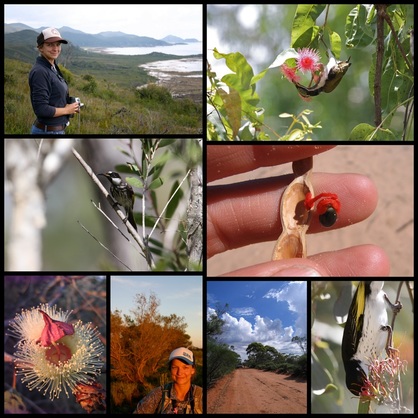
Foraging behavior, behavioral flexibility, and range size of Australian honeyeaters (Meliphagidae)
I study how avian life history traits and behavior can determine responses to disturbance. My dissertation research utilizes a large dataset of Australian Meliphagidae (honeyeaters) foraging behavior characteristics that my collaborator and I collected across Australia, including Tasmania. The Meliphagidae family is the most abundant Australian passerine group in both number of species and individuals. They occupy a diversity of foraging niches, which makes them an ideal family for this study. Over the course of 18 months, we collected over 7,300 independent observations on 74 species according to standardized protocols. This dataset contributes tremendously to our knowledge on the natural history of this family. We are using it to examine how foraging behavior shifts across the phylogeny, and how these behaviors relate to species’ response to disturbance. From this intersection of animal behavior and macroecology, we can shed new light on our precision in predicting species’ responses to future change.
I study how avian life history traits and behavior can determine responses to disturbance. My dissertation research utilizes a large dataset of Australian Meliphagidae (honeyeaters) foraging behavior characteristics that my collaborator and I collected across Australia, including Tasmania. The Meliphagidae family is the most abundant Australian passerine group in both number of species and individuals. They occupy a diversity of foraging niches, which makes them an ideal family for this study. Over the course of 18 months, we collected over 7,300 independent observations on 74 species according to standardized protocols. This dataset contributes tremendously to our knowledge on the natural history of this family. We are using it to examine how foraging behavior shifts across the phylogeny, and how these behaviors relate to species’ response to disturbance. From this intersection of animal behavior and macroecology, we can shed new light on our precision in predicting species’ responses to future change.

Avian community response to a non-native invasive index of riparian vegetation in northwestern New Mexico
In riparian areas of the arid and semi-arid western North America, invasive tamarisk and Russian olive threaten native cottonwood and willow habitats. These native woodlands are known to maintain among the highest avian densities and species richness totals in temperate North America. This high diversity is brought about via habitat heterogeneity that provides nesting substrates, cavities, and food resources for many species. Although resource managers actively manage these invasive species, the effects of invasive vegetation on bird communities are site- and species-specific. Why some species, guilds, and families do poorly and others thrive in the face of invasion is only beginning to be understood. We utilized a gradient of native to invasive riparian vegetation on the San Juan and Animas Rivers in northwest New Mexico, and conducted point count surveys, vegetation assessments, and prey surveys to address how avian communities, species, and guilds respond to invasive vegetation. We took a life history approach, and identified which characteristics predispose these species to success or failure in invasive vegetation. Overall, sites containing predominantly native vegetation had higher species richness and diversity than predominantly invasive sites, and responses to the vegetation gradient are species-specific. We found that occupancy likelihood for omnivores, certain members of the aerial forager guild, and Emberizidae family members increased with invasion. Alternatively, cavity nesting species, frugivorous species, and many insectivorous species decreased with increased proportions of invasion. Avian prey diversity and evenness showed a negative relationship with increased proportion of invasive vegetation. My approach of exploring the consequences of invasion on a gradient scale, viewed from an avian life history framework, provided insight and a potentially applicable approach to conservation in the region (Wagner et al. in review).
In riparian areas of the arid and semi-arid western North America, invasive tamarisk and Russian olive threaten native cottonwood and willow habitats. These native woodlands are known to maintain among the highest avian densities and species richness totals in temperate North America. This high diversity is brought about via habitat heterogeneity that provides nesting substrates, cavities, and food resources for many species. Although resource managers actively manage these invasive species, the effects of invasive vegetation on bird communities are site- and species-specific. Why some species, guilds, and families do poorly and others thrive in the face of invasion is only beginning to be understood. We utilized a gradient of native to invasive riparian vegetation on the San Juan and Animas Rivers in northwest New Mexico, and conducted point count surveys, vegetation assessments, and prey surveys to address how avian communities, species, and guilds respond to invasive vegetation. We took a life history approach, and identified which characteristics predispose these species to success or failure in invasive vegetation. Overall, sites containing predominantly native vegetation had higher species richness and diversity than predominantly invasive sites, and responses to the vegetation gradient are species-specific. We found that occupancy likelihood for omnivores, certain members of the aerial forager guild, and Emberizidae family members increased with invasion. Alternatively, cavity nesting species, frugivorous species, and many insectivorous species decreased with increased proportions of invasion. Avian prey diversity and evenness showed a negative relationship with increased proportion of invasive vegetation. My approach of exploring the consequences of invasion on a gradient scale, viewed from an avian life history framework, provided insight and a potentially applicable approach to conservation in the region (Wagner et al. in review).
